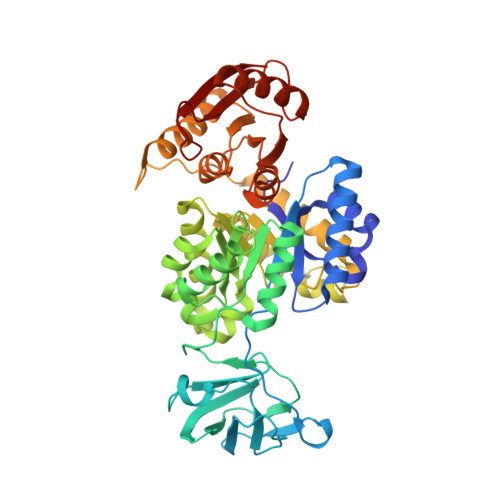Grappling with anisotropic data, pseudo-merohedral twinning and pseudo-translational noncrystallographic symmetry: a case study involving pyruvate kinase.
Donovan, K.A., Atkinson, S.C., Kessans, S.A., Peng, F., Cooper, T.F., Griffin, M.D., Jameson, G.B., Dobson, R.C.(2016) Acta Crystallogr D Struct Biol 72: 512-519
- PubMed: 27050130
- DOI: https://doi.org/10.1107/S205979831600142X
- Primary Citation of Related Structures:
4YNG - PubMed Abstract:
Pyruvate kinase is a key regulatory enzyme involved in the glycolytic pathway. The crystal structure of Escherichia coli type I pyruvate kinase was first solved in 1995 at 2.5 Å resolution. However, the space group was ambiguous, being either primitive orthorhombic (P2(1)2(1)2(1)) or C-centred orthorhombic (C222(1)). Here, the structure determination and refinement of E. coli type I pyruvate kinase to 2.28 Å resolution are presented. Using the same crystallization conditions as reported previously, the enzyme was found to crystallize in space group P2(1). Determination of the space group was complicated owing to anisotropic data, pseudo-translational noncrystallographic symmetry and the pseudo-merohedrally twinned nature of the crystal, which was found to have very close to 50% twinning, leading to apparent orthorhombic symmetry and absences that were not inconsistent with P2(1)2(1)2(1). The unit cell contained two tetramers in the asymmetric unit (3720 residues) and, when compared with the orthorhombic structure, virtually all of the residues could be easily modelled into the density. Averaging of reflections into the lower symmetry space group with twinning provided tidier electron density that allowed ∼30 missing residues of the lid domain to be modelled for the first time. Moreover, residues in a flexible loop could be modelled and sulfate molecules are found in the allosteric binding domain, identifying the pocket that binds the allosteric activator fructose 1,6-bisphosphate in this isozyme for the first time. Lastly, we note the pedagogical benefits of difficult structures to emerging crystallographers.
Organizational Affiliation:
Biomolecular Interaction Centre and School of Biological Sciences, University of Canterbury, Private Bag 4800, Christchurch 8041, New Zealand.















